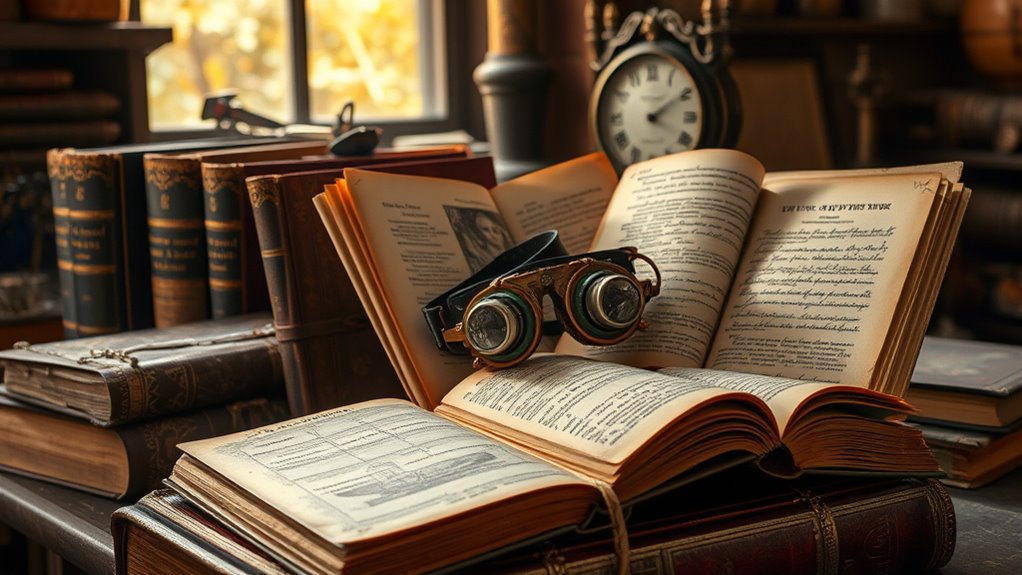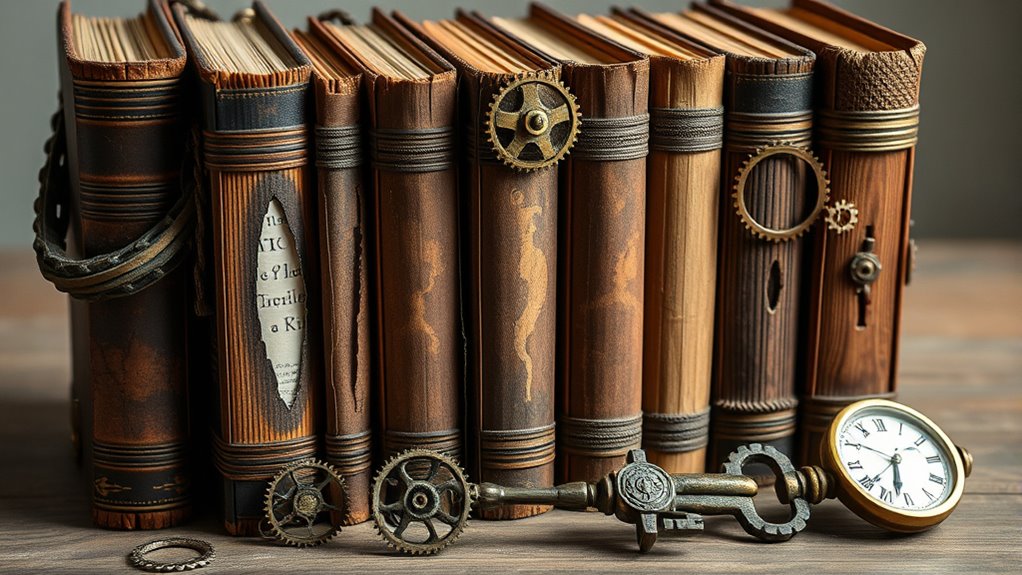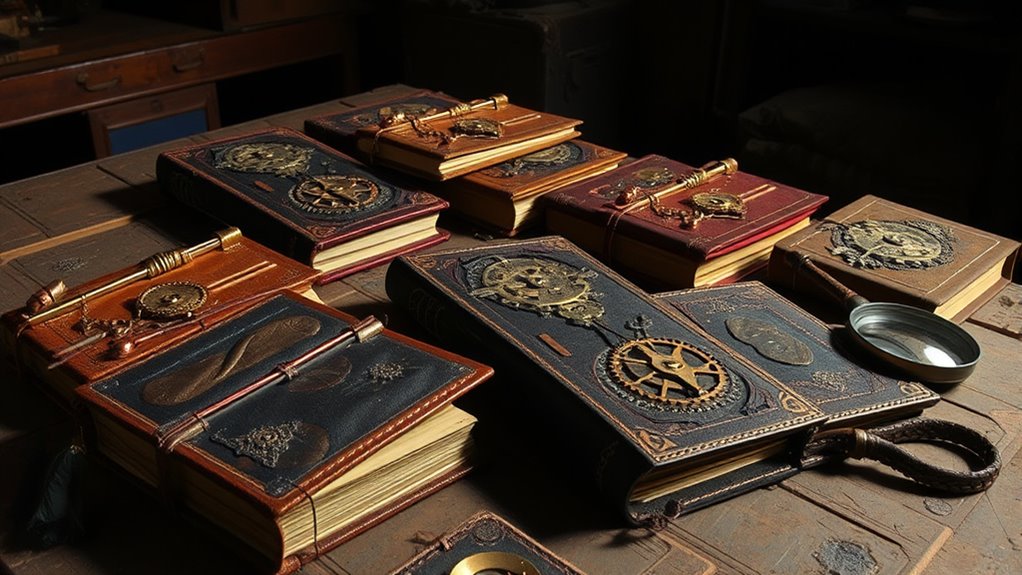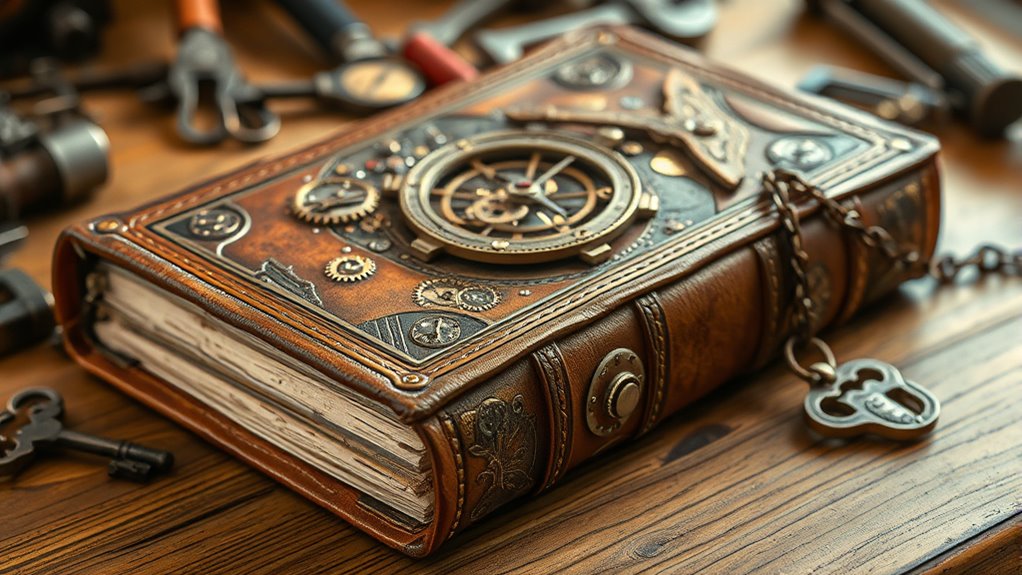If you want to create stunning steampunk book covers, start by repurposing old books. Remove the covers and salvage valuable materials like illustrated pages and greyboard. For the cover, use rugged textures like leather and distressed paper. Incorporate steampunk motifs—think gears, clockwork, and vintage colors—to evoke a dynamic aesthetic. Don't forget to add mixed media elements like ink sprays and die cuts for depth. There's much more you can explore for unique designs and techniques.
Key Takeaways
- Select old books with sturdy covers and decorative pages for repurposing into steampunk-themed projects.
- Remove the original covers to access reusable materials like greyboard and illustrated pages.
- Use rugged materials like leather and distressed papers for creating authentic steampunk book covers.
- Incorporate embellishments like gears, clockwork motifs, and watch mechanisms to enhance the steampunk aesthetic.
- Experiment with mixed media techniques, such as ink sprays and die cuts, to add texture and depth to your covers.
Understanding the Steampunk Aesthetic

While you might associate steampunk primarily with literature, it's much more than just a genre; it's a rich aesthetic that blends elements of technofantasy, hyper-vintage, and retrofuturism.
Drawing inspiration from the 19th-century Victorian era, it emphasizes steam power and industrial machinery. Over time, steampunk has evolved, influencing art, fashion, decor, and lifestyle. The concept of steampunk as a "container" allows for diverse interpretations and expressions, further enriching its aesthetic.
Core features of this aesthetic include gears, exposed metal, and steam-powered elements, all of which create a unique visual language.
The aesthetic of steampunk is defined by its intricate gears, gleaming metal, and imaginative steam-powered designs.
You'll notice how steampunk permeates various cultural forms, including music and even political expressions.
As you explore steampunk, you'll discover its fascinating amalgamation of plausible technology and fantastical design, inviting you to imagine a world where the past meets the future.
Essential Repurposing Techniques for Old Books

Repurposing old books opens up a world of creative possibilities, allowing you to transform forgotten texts into unique treasures. Start by identifying valuable materials like greyboard, endpapers, and decorative pages. Remove the covers to access these resources. Save illustrated pages and maps for future crafts, and gather reusable endbands for new projects. Additionally, old books can be recycled, reclaiming materials for crafts and bookbinding.
Use a knife for precise cuts, a bone folder for shaping, and a ruler for accuracy. Try book folding techniques for decorative designs or sewing to create new bindings. You can also turn old pages into notebooks or wall art using a Cricut. By incorporating embellishments like gears, you'll enhance your creations while reducing waste and supporting sustainable practices.
Crafting Unique Steampunk Book Covers

Transforming old books into unique steampunk covers offers a fantastic way to blend creativity with nostalgia. Start by selecting rugged materials like leather, metal, and distressed papers that evoke a vintage feel. Incorporate decorative motifs such as gears and clockwork mechanisms, drawing inspiration from industrial landscapes. Use earthy tones like brown and copper, accented with metallic hues like brass and bronze for an authentic touch. Employ embellishment techniques like stamping and gilding to add depth and texture. Consider integrating motifs like airships or steam-powered machinery into your design to reinforce the steampunk theme. Each cover you create will reflect your artistic vision, making it a one-of-a-kind piece that embodies both history and innovation. Additionally, the choice of subject plays a significant role in ensuring that your designs resonate with the intended audience.
Incorporating Mixed Media Elements

How can you elevate your steampunk book covers with mixed media elements? Start by applying multiple layers of gesso for texture and a solid base. Use ink sprays, like Lindy's or Dylusions, to create distress effects and an aged look. Incorporate die cuts featuring gears or clockwork designs to enhance the steampunk vibe. Consider adding bronze page corner protectors and gear charms as embellishments for extra flair. Multiple layers of texture paste, whether homemade or store-bought, can introduce depth and dimension to your cover. Don't forget to experiment with stencils and mists for detailed backgrounds. By blending these mixed media techniques, you'll create a unique and visually striking steampunk book cover that stands out.
Enhancing Your Cover With Steampunk Embellishments

Elevate your steampunk book cover by layering on unique embellishments that capture the essence of this imaginative genre.
Start with gear charms in various sizes to add a mechanized touch, then integrate watch mechanisms for that nostalgic vibe. Chipboard and plastic decorations can also be used to enhance the cover's texture and dimension.
Consider bronze curb chains to create an industrial feel, while metal stamps can enhance intricate patterns. To protect your book, add bronze page corner protectors that also serve as decorative elements.
Use acrylic or metallic paints to give your embellishments a copper finish, and apply distress ink for a vintage effect. Finally, strategically place metallic tassels and vintage ribbons to complete your design, ensuring a cohesive color theme that embodies the steampunk aesthetic.
Frequently Asked Questions
What Types of Old Books Are Best for Repurposing?
When you're looking to repurpose old books, focus on hardcovers with sewn bindings for durability.
Choose books with paper surfaces for easier modifications and larger sizes for more intricate designs.
Opt for older books for added vintage charm, but ensure they're in good condition.
Pocket dictionaries work well for junk journals, while leather-bound books add elegance to decorative pieces.
Can I Use Digital Tools for Steampunk Cover Designs?
Yes, you can definitely use digital tools for steampunk cover designs.
Software like Adobe Photoshop and Illustrator offers you powerful features to create intricate designs. You can easily incorporate elements like gears, steam effects, and vintage textures.
Plus, with extensive online libraries, you can access a wide range of steampunk-themed graphics. By manipulating colors and textures digitally, you'll achieve the unique aesthetic that defines steampunk art.
It's an exciting way to bring your vision to life!
Where Can I Find Steampunk-Themed Embellishments?
In the vast ocean of creativity, steampunk-themed embellishments await your discovery like hidden treasures beneath the waves.
You can explore online platforms like Etsy or Scrapbook.com for unique items, from gears to decorative metal pieces. Specialty craft stores, such as Michael's or Hobby Lobby, often showcase steampunk sections.
Don't overlook antique shops and flea markets, where vintage finds can spark your imagination and elevate your projects with authentic charm.
How Do I Properly Age a Book Cover?
To properly age a book cover, you can start by coffee staining for a deep look, but be careful with readability.
Try using alcohol-based dyes for more control, or dry brushing for subtle effects.
Natural sunlight exposure can work, but it takes time.
If you want texture, sandpaper or distressing tools are great.
Finally, finish with a clear coat to protect your aged cover from further damage.
Enjoy the process!
What Are Some Common Mistakes When Crafting Steampunk Covers?
When crafting steampunk covers, you might find yourself drowning in a sea of common mistakes!
Using books with plastic coatings? That'll ruin your adhesion faster than a steam-powered train derailing!
Forgetting to prime surfaces can lead to paint peeling like old wallpaper.
And if you rush drying times, your masterpiece could end up looking like a chaotic mess.
Conclusion
By repurposing old books into stunning steampunk covers, you're not just creating art; you're breathing new life into forgotten stories. Imagine holding a book that's not just a vessel for words, but a unique piece of history, adorned with gears, leather, and vintage flair. With your newfound skills and creativity, you can transform ordinary materials into extraordinary treasures. So, why not let your imagination run wild and craft a cover that sparks curiosity and wonder?









